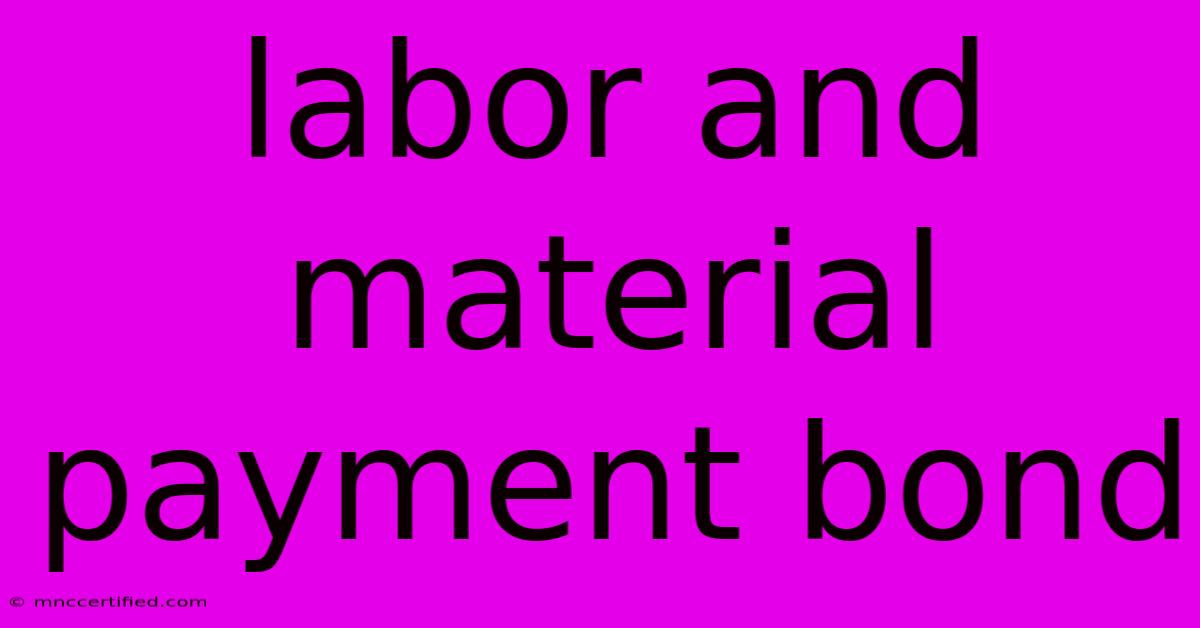Labor And Material Payment Bond

Table of Contents
Understanding Labor and Material Payment Bonds: A Comprehensive Guide
A construction project's success hinges on timely and complete payments to all involved parties. This is where a labor and material payment bond, often referred to as a payment bond, plays a crucial role. This comprehensive guide will delve into what these bonds are, why they're essential, and how they protect various stakeholders in the construction process.
What is a Labor and Material Payment Bond?
A labor and material payment bond is a type of surety bond guaranteeing that a contractor will pay all subcontractors, material suppliers, and laborers for work performed and materials supplied on a construction project. It essentially acts as an insurance policy, protecting these parties from financial losses if the contractor defaults on their payments. The bond is issued by a surety company, a financial institution that guarantees the performance of a contractual obligation.
Key Players Involved:
- Obligee: The entity requiring the bond, typically the project owner.
- Principal: The contractor undertaking the construction project.
- Surety: The insurance company guaranteeing the contractor's payment obligations.
Why are Labor and Material Payment Bonds Important?
These bonds provide crucial protection for several stakeholders:
1. Protecting Subcontractors and Suppliers:
Subcontractors and material suppliers often bear significant costs upfront, investing time and resources before receiving payment from the general contractor. A payment bond ensures they're compensated even if the contractor fails to pay them, mitigating financial risk and preventing potential business failures.
2. Protecting Project Owners:
Owners benefit from payment bonds by reducing the likelihood of liens being filed against their property. Unpaid subcontractors and suppliers can file mechanic's liens, placing a claim on the property until their payments are settled. Payment bonds help avoid this costly and time-consuming legal process.
3. Ensuring Project Completion:
By safeguarding the financial interests of all parties involved, payment bonds contribute to smoother project execution. Knowing they'll be paid, subcontractors and suppliers are more likely to complete their work on time and to the agreed-upon standard. This reduces project delays and cost overruns.
How Does a Labor and Material Payment Bond Work?
The process typically involves these steps:
- Bond Requirement: The project owner mandates a payment bond as part of the construction contract.
- Application & Underwriting: The contractor applies to a surety company, providing financial information for assessment.
- Bond Issuance: If approved, the surety company issues the payment bond, guaranteeing the contractor's payment obligations.
- Claims Process: If the contractor fails to pay a subcontractor or supplier, the unpaid party can file a claim with the surety company.
- Surety's Obligation: The surety investigates the claim and, if valid, pays the claimant. The surety then pursues recovery from the contractor.
Types of Payment Bonds:
While the term "labor and material payment bond" is commonly used, there are nuances:
- Payment Bond: This is the most common type, covering labor and materials.
- Performance Bond: This bond guarantees that the contractor will complete the project according to the contract specifications. While distinct, it often accompanies a payment bond.
Finding the Right Surety Bond:
Choosing the right surety company is crucial. Consider factors such as:
- Financial Strength: Ensure the surety company has a strong financial rating.
- Experience: Select a company with extensive experience in the construction industry.
- Reputation: Look for a surety company with a positive reputation and excellent customer service.
Frequently Asked Questions (FAQs):
Q: What is the difference between a performance bond and a payment bond?
A: A performance bond guarantees project completion, while a payment bond guarantees payment to subcontractors and suppliers. They often work together to protect the project owner.
Q: Who is responsible for the cost of the payment bond?
A: Typically, the contractor is responsible for the cost of the payment bond, which is factored into their bid.
Q: How long is a payment bond valid?
A: The validity period is typically tied to the project's completion and often extends beyond to allow for potential claims.
Conclusion:
Labor and material payment bonds are indispensable tools in the construction industry, offering significant protection to project owners, contractors, subcontractors, and suppliers. Understanding their function and importance is vital for navigating the complexities of construction projects and ensuring smooth, financially secure operations. This comprehensive overview should provide a strong foundation for anyone involved in, or interested in, the construction sector.

Thank you for visiting our website wich cover about Labor And Material Payment Bond. We hope the information provided has been useful to you. Feel free to contact us if you have any questions or need further assistance. See you next time and dont miss to bookmark.
Featured Posts
-
What Does Bond Status Acti Mean
Nov 23, 2024
-
Ionic Covalent Bonding Webquest
Nov 23, 2024
-
Best Way To Bond Metal To Metal
Nov 23, 2024
-
2018 Mc Gregor Hotel Rape Guilty
Nov 23, 2024
-
Redicks Lakers Loss A Dark Place
Nov 23, 2024